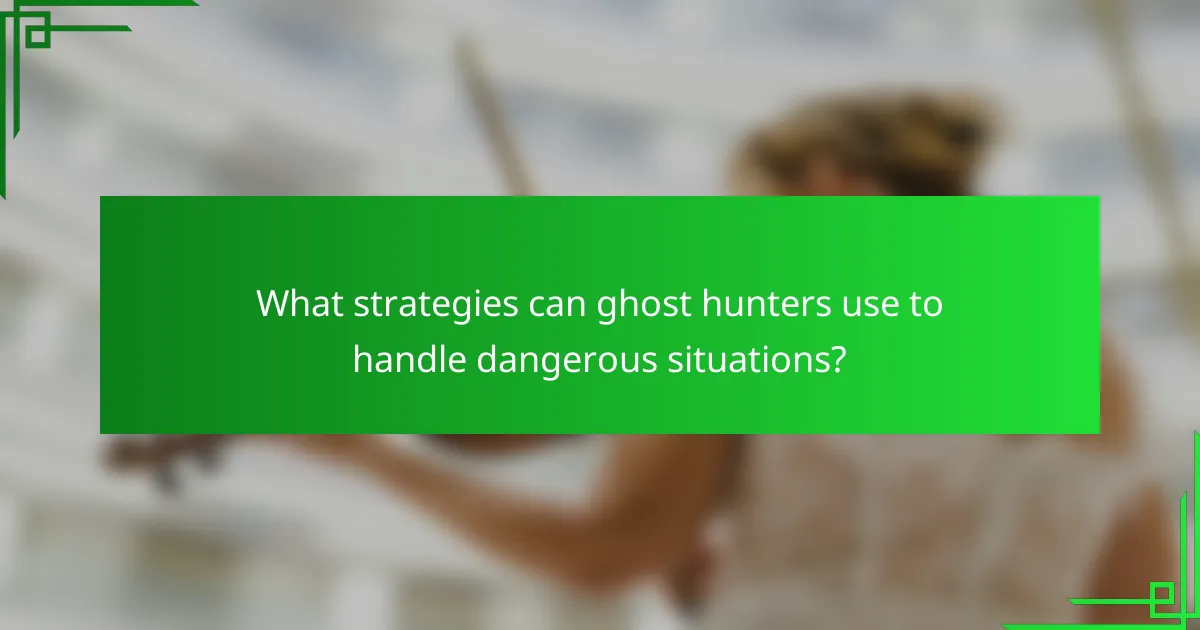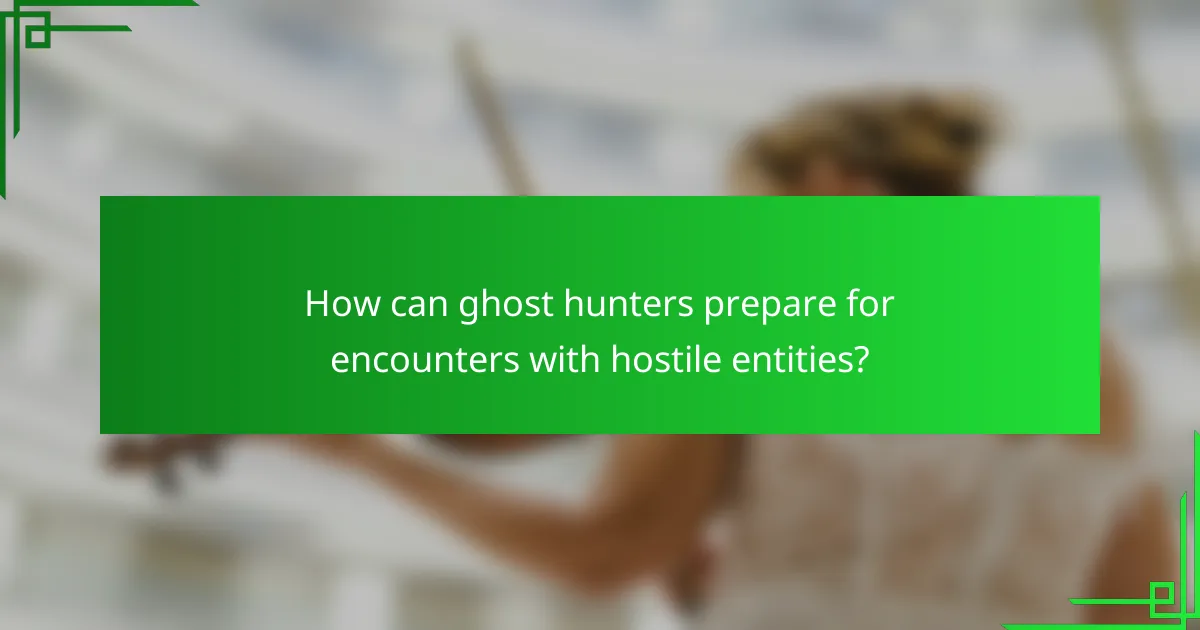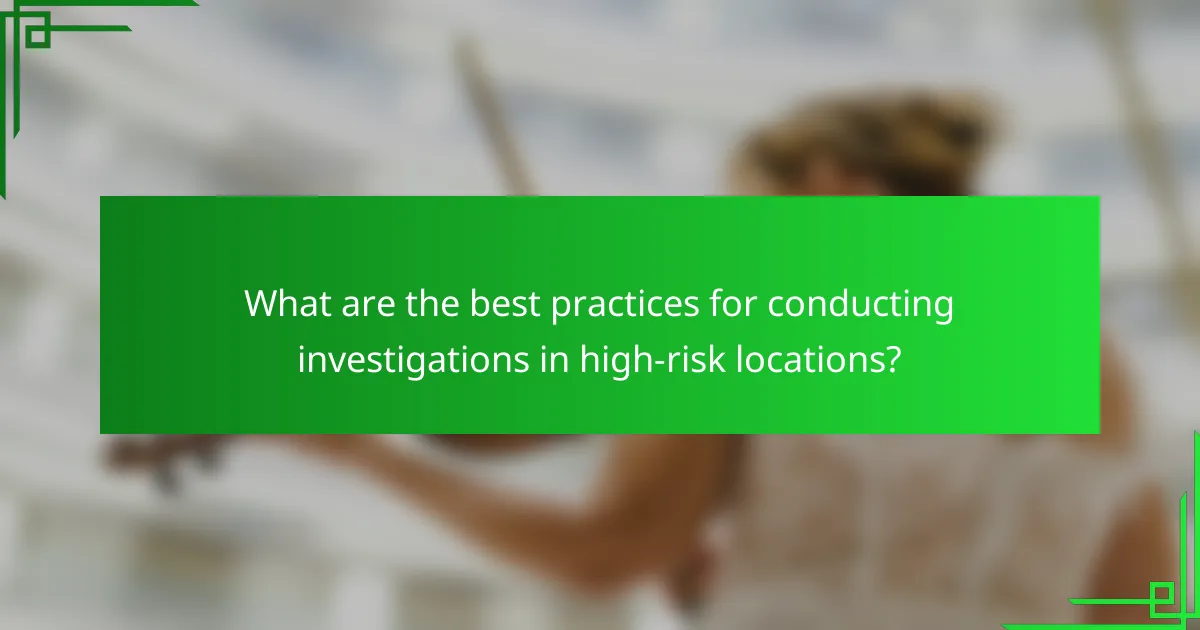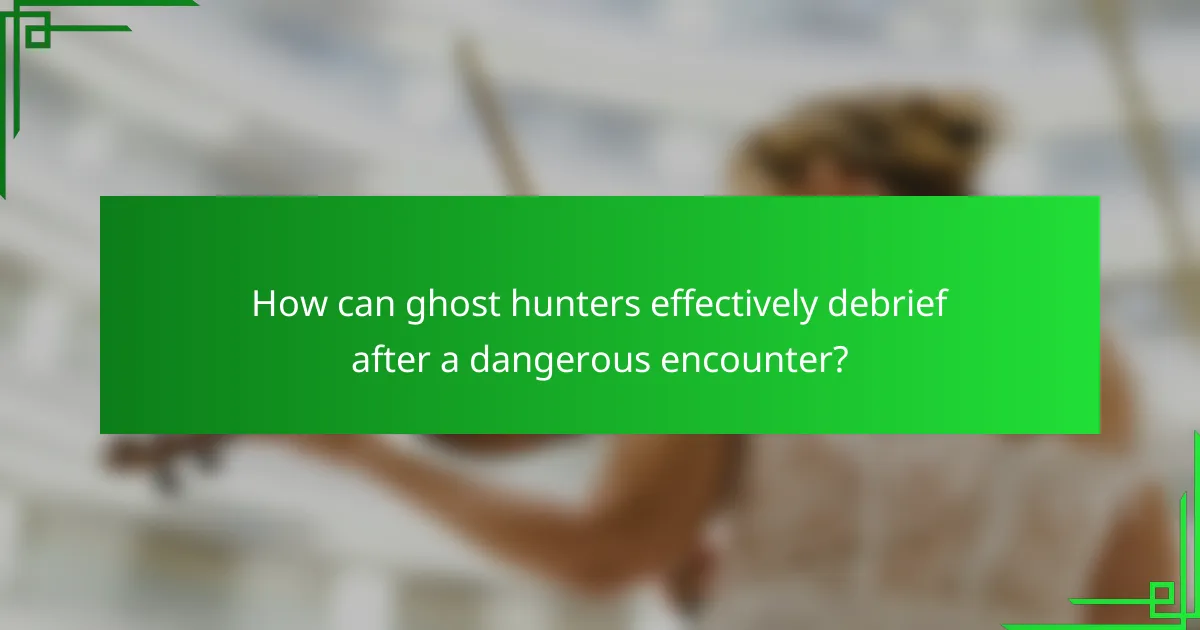Ghost hunters face unique challenges that require careful planning and strategic approaches to ensure safety during investigations. By establishing emergency communication plans, utilizing safety equipment, and enhancing situational awareness, teams can effectively manage dangerous situations. Additionally, understanding the nature of potential threats and preparing both mentally and practically can help mitigate risks and ensure a successful investigation.

What strategies can ghost hunters use to handle dangerous situations?
Ghost hunters can employ several strategies to effectively manage dangerous situations, ensuring safety and preparedness. Key approaches include establishing emergency communication plans, utilizing appropriate safety equipment, training teams adequately, enhancing situational awareness, and developing clear exit strategies.
Emergency communication plans
Creating an emergency communication plan is essential for ghost hunters operating in potentially hazardous environments. This plan should outline how team members will contact each other and emergency services if needed, using devices like walkie-talkies or mobile phones.
Regularly test communication devices before investigations to ensure they function properly in remote areas. Establishing a check-in schedule can also help keep everyone informed about each other’s status throughout the investigation.
Safety equipment recommendations
Equipping the team with the right safety gear is crucial for minimizing risks during ghost hunts. Essential items include first aid kits, flashlights, sturdy footwear, and personal protective equipment such as gloves and masks.
Consider adding specialized tools like EMF detectors and thermal cameras, which can help identify potentially dangerous situations. Always ensure that equipment is in good condition and that team members are familiar with its use.
Team training protocols
Implementing training protocols for the team can significantly enhance safety during ghost hunting. Regular training sessions should cover emergency procedures, equipment usage, and first aid skills to prepare members for various scenarios.
Encourage team members to participate in workshops or courses related to safety in paranormal investigations. This ongoing education can help them recognize and respond to dangerous situations more effectively.
Situational awareness techniques
Developing situational awareness is vital for ghost hunters to identify potential hazards quickly. Team members should be trained to observe their surroundings, noting any unusual sounds, movements, or environmental changes that may indicate danger.
Practicing mindfulness techniques can help team members stay focused and alert during investigations. Encourage regular discussions about experiences and observations to foster a culture of awareness within the team.
Exit strategies
Establishing clear exit strategies is crucial for ensuring a safe retreat from potentially dangerous situations. Each investigation site should have designated exit routes that all team members are familiar with before starting the hunt.
Conduct a walkthrough of the location to identify exits and potential obstacles. In case of an emergency, having a predetermined plan can save valuable time and reduce panic among team members.

How can ghost hunters prepare for encounters with hostile entities?
Ghost hunters can prepare for encounters with hostile entities by understanding the nature of these entities and employing protective measures. Preparation involves both mental readiness and practical tools to mitigate risks during investigations.
Understanding entity behavior
Recognizing the behavior of hostile entities is crucial for ghost hunters. Many entities may exhibit aggressive or unpredictable actions, often influenced by their past experiences or emotional states. Familiarizing oneself with common signs of hostility, such as sudden temperature drops or disembodied voices, can help in assessing the situation quickly.
It’s also beneficial to study local folklore and historical accounts related to specific locations. This knowledge can provide insights into the types of entities that may be encountered and their typical behaviors, allowing hunters to tailor their approach accordingly.
Protective rituals and tools
Employing protective rituals and tools can significantly enhance safety during ghost hunts. Common protective measures include carrying crystals like black tourmaline or using sage for smudging to cleanse spaces. Additionally, many hunters utilize protective symbols or talismans that resonate with their personal beliefs.
Creating a ritual before entering a potentially hostile environment can also be effective. This might involve setting intentions, reciting affirmations, or invoking spiritual guides for protection. Having a well-defined plan and tools ready can help maintain focus and confidence during encounters.
Psychological preparation methods
Psychological preparation is essential for managing fear and anxiety when facing hostile entities. Practicing mindfulness and grounding techniques can help hunters remain calm and centered. Techniques such as deep breathing or visualization can be employed to maintain composure in unsettling situations.
Additionally, discussing experiences with fellow ghost hunters can provide emotional support and practical advice. Building a strong support network can help individuals feel more secure and equipped to handle challenging encounters, reducing the likelihood of panic during investigations.

What are the best practices for conducting investigations in high-risk locations?
To conduct investigations in high-risk locations safely, ghost hunters should prioritize thorough preparation, awareness of local regulations, and effective communication with authorities. Implementing structured checklists and understanding the legal landscape can significantly mitigate risks during investigations.
Site assessment checklists
Creating a site assessment checklist is essential for evaluating high-risk locations before conducting investigations. This checklist should include factors such as structural integrity, environmental hazards, and accessibility. For example, assess whether the building is stable, check for potential hazards like exposed wiring, and ensure that emergency exits are clearly marked.
Additionally, consider including a section for documenting any previous incidents or reports related to the site. This information can provide valuable context and help in planning the investigation more effectively.
Local laws and regulations
Understanding local laws and regulations is crucial for ghost hunters operating in high-risk areas. Each region may have specific rules regarding trespassing, noise ordinances, and the use of recording equipment. Familiarize yourself with these regulations to avoid legal complications during your investigations.
For instance, some locations may require permits for nighttime investigations or the use of drones. Always check with local authorities to ensure compliance and to avoid potential fines or legal issues.
Partnerships with local authorities
Establishing partnerships with local authorities can enhance safety and cooperation during ghost hunting investigations. Engaging with law enforcement or fire departments can provide insights into the area and help ensure a quick response in case of emergencies.
Consider reaching out to local officials before an investigation to inform them of your plans. This proactive approach can foster goodwill and may even lead to valuable advice on navigating the site safely. Additionally, having local authorities aware of your presence can deter potential issues with trespassing or disturbances.

What equipment is essential for ensuring safety during investigations?
Essential equipment for ensuring safety during ghost hunting investigations includes personal protective gear, communication devices, and first aid kits. These tools help mitigate risks and provide support in potentially hazardous environments.
Personal protective gear
Personal protective gear is crucial for safeguarding against physical hazards during investigations. This may include sturdy footwear, gloves, and protective clothing to prevent injuries from sharp objects or rough terrain.
Consider using items like knee pads and hard hats in locations with unstable structures. Always ensure that your gear is comfortable and fits well to maintain mobility while exploring.
Communication devices
Reliable communication devices are vital for maintaining contact with team members during investigations. Walkie-talkies or two-way radios are preferred for their durability and long-range capabilities, especially in areas with poor cell service.
Establish a communication protocol before starting the investigation. This should include designated channels, check-in times, and emergency signals to ensure everyone stays connected and safe.
First aid kits
A well-stocked first aid kit is essential for addressing minor injuries that may occur during ghost hunting. Kits should include items like bandages, antiseptics, pain relievers, and any personal medications team members may need.
Regularly check and replenish your first aid kit to ensure all supplies are up-to-date and effective. Consider training team members in basic first aid to enhance safety and preparedness during investigations.

How can ghost hunters effectively debrief after a dangerous encounter?
Ghost hunters can effectively debrief after a dangerous encounter by conducting a structured review of the incident, focusing on key observations and emotional responses. This process helps to identify lessons learned and improve future safety measures.
Incident reporting templates
Incident reporting templates are essential tools for ghost hunters to document their experiences systematically. A well-structured template should include sections for date, time, location, team members present, and a detailed account of the encounter.
Consider including a section for emotional responses and any immediate actions taken during the incident. This can help teams reflect on their reactions and improve decision-making in future situations.
For effective reporting, templates can be customized to fit specific types of encounters, whether they involve physical threats or psychological distress. A simple checklist format can streamline the process, ensuring that all critical aspects are covered.
